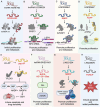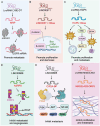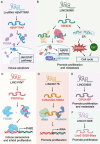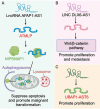LncRNA-encoded peptides in cancer
- PMID: 39135098
- PMCID: PMC11320871
- DOI: 10.1186/s13045-024-01591-0
LncRNA-encoded peptides in cancer
Abstract
Long non-coding RNAs (lncRNAs), once considered transcriptional noise, have emerged as critical regulators of gene expression and key players in cancer biology. Recent breakthroughs have revealed that certain lncRNAs can encode small open reading frame (sORF)-derived peptides, which are now understood to contribute to the pathogenesis of various cancers. This review synthesizes current knowledge on the detection, functional roles, and clinical implications of lncRNA-encoded peptides in cancer. We discuss technological advancements in the detection and validation of sORFs, including ribosome profiling and mass spectrometry, which have facilitated the discovery of these peptides. The functional roles of lncRNA-encoded peptides in cancer processes such as gene transcription, translation regulation, signal transduction, and metabolic reprogramming are explored in various types of cancer. The clinical potential of these peptides is highlighted, with a focus on their utility as diagnostic biomarkers, prognostic indicators, and therapeutic targets. The challenges and future directions in translating these findings into clinical practice are also discussed, including the need for large-scale validation, development of sensitive detection methods, and optimization of peptide stability and delivery.
Keywords: Application; Cancer; Long non-coding RNA; Peptide; Small open reading frame.
© 2024. The Author(s).
Conflict of interest statement
The authors declare no competing interests.
Figures










Similar articles
-
CircRNA and lncRNA-encoded peptide in diseases, an update review.Mol Cancer. 2024 Sep 30;23(1):214. doi: 10.1186/s12943-024-02131-7. Mol Cancer. 2024. PMID: 39343883 Free PMC article. Review.
-
Micropeptides derived from long non-coding RNAs: Computational analysis and functional roles in breast cancer and other diseases.Gene. 2025 Jan 30;935:149019. doi: 10.1016/j.gene.2024.149019. Epub 2024 Oct 24. Gene. 2025. PMID: 39461573 Review.
-
Cancer-related micropeptides encoded by ncRNAs: Promising drug targets and prognostic biomarkers.Cancer Lett. 2022 Oct 28;547:215723. doi: 10.1016/j.canlet.2022.215723. Epub 2022 May 7. Cancer Lett. 2022. PMID: 35533953 Review.
-
Clinical prospects and research strategies of long non-coding RNA encoding micropeptides.Zhejiang Da Xue Xue Bao Yi Xue Ban. 2023 Aug 25;52(4):397-405. doi: 10.3724/zdxbyxb-2023-0128. Zhejiang Da Xue Xue Bao Yi Xue Ban. 2023. PMID: 37643974 Free PMC article. Review. Chinese, English.
-
Mining for missed sORF-encoded peptides.Expert Rev Proteomics. 2019 Mar;16(3):257-266. doi: 10.1080/14789450.2019.1571919. Epub 2019 Feb 13. Expert Rev Proteomics. 2019. PMID: 30669886 Review.
Cited by
-
Role of long noncoding RNAs in the regulation of epithelial‑mesenchymal transition in osteosarcoma (Review).Oncol Rep. 2025 Mar;53(3):35. doi: 10.3892/or.2025.8868. Epub 2025 Jan 24. Oncol Rep. 2025. PMID: 39930817 Free PMC article. Review.
-
Long noncoding RNA VPS9D1-AS1 promotes angiogenesis in colorectal cancer by regulating the VEGFA signalling pathway.Am J Cancer Res. 2025 Apr 15;15(4):1673-1688. doi: 10.62347/BKUV1210. eCollection 2025. Am J Cancer Res. 2025. PMID: 40371141 Free PMC article.
-
Advances in the application of extracellular vesicles in precise diagnosis of pancreatic cancer.Eur J Med Res. 2025 Jun 13;30(1):478. doi: 10.1186/s40001-025-02739-5. Eur J Med Res. 2025. PMID: 40514731 Free PMC article. Review.
-
The regulatory role and therapeutic potential of long non-coding RNA in non-small cell lung cancer.J Cancer. 2025 Jan 6;16(4):1137-1148. doi: 10.7150/jca.103182. eCollection 2025. J Cancer. 2025. PMID: 39895777 Free PMC article. Review.
-
CircRNA and lncRNA-encoded peptide in diseases, an update review.Mol Cancer. 2024 Sep 30;23(1):214. doi: 10.1186/s12943-024-02131-7. Mol Cancer. 2024. PMID: 39343883 Free PMC article. Review.
References
Publication types
MeSH terms
Substances
Grants and funding
LinkOut - more resources
Full Text Sources
Medical

